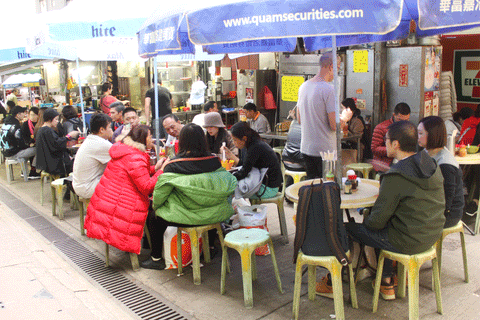The fall has officially arrived in Hong Kong now and the temperature is dropping. It's therefore the perfect time to go to the few Dai Pai Dongs left in Hong Kong to enjoy a meal outside (without sweating). How to know it is a Dai Pai Dong? It's simple, the kitchen is outside, some men are standing there with their woks, there are flames, round tables covered in plastic, folding chairs and happy people.
Hong Kong is known for being a food paradise. The city is the home to around 15.000 restaurants, which makes the restaurant density one of the highest in the world. Among all these restaurants, there is one type of restaurant with only 25 places left, the Dai Pai Dongs. A Dai Pai Dong is an open air food stall, usually placed in alleys, sidewalks or in the streets. The food these stalls is serving is fast paced made food, with lots of variation in taste and ingredients. The food is usually prepared with a wok, which gives an extra unique taste and aroma locally called and known as Wok Hei.

They appeared for full course after the Second World war as they served cheap, affordable and filling foods during a hard time in the city. The government at this time easily issued the licence for operation to families who had suffered loss or had gotten injuries during the war that made working difficult. The licence itself was big and had to be hanging on the wall of the stall and therefore the name Dai Pai Dong (Dai Pai - Big licence). Because many people got the licence to have a Dai Pai Dong, they started to flourish all over the city. Some even say that there were 3000 Dai Pai Dongs in Hong Kong at one time.
Even though the Dai Pai Dongs were helping families earn a living after the war, it also created some complications. The stalls were creating traffic congestions, and the hygiene was not as good as it should have been. There were also problems related to people renting out their DPD on the black market. Therefore the government stopped issuing the licence in 1956. They also changed how people could transfer the licence. Earlier people could inherit the licence from their parents, but the government changed the inherit rule and then only spouses could take over the DPD. This meant that the Dai Pai Dong would slowly dissolve over the year as renewal or inheritance would be impossible. This explains why there are only 25 Dai Pai Dongs left in Hong Kong today. The few remaining ones are located in Central, Wan Chai, Sham Shui Po, Tai O and Tai Hang.

The Dai Pai dong has been a part of Hong Kong culture for decades and is something that is typical Hong Kong. However, because a licence cant be renewed these places are disappearing as the owners of the licence dies. This means that the culture is dying as well. The Dai Pai Dong is a clear representation of Hong Kong culture. These restaurants gather people to enjoy a good meal with friends and family. It is also said that people become friends when eating at a Dai Pai Dong because you will share a table with people you don't know from before.
This means that you should go to a Dai Pai Dong as soon as possible, because they are going to be gone one day in the near future. Keep the spirit of Hong Kong alive and enjoy some Wok Hei.
Which Dai Pai Dong is your favourite?
Picture Credit:
South China Morning Post
That Food Cray
Fodors Travel Guide


